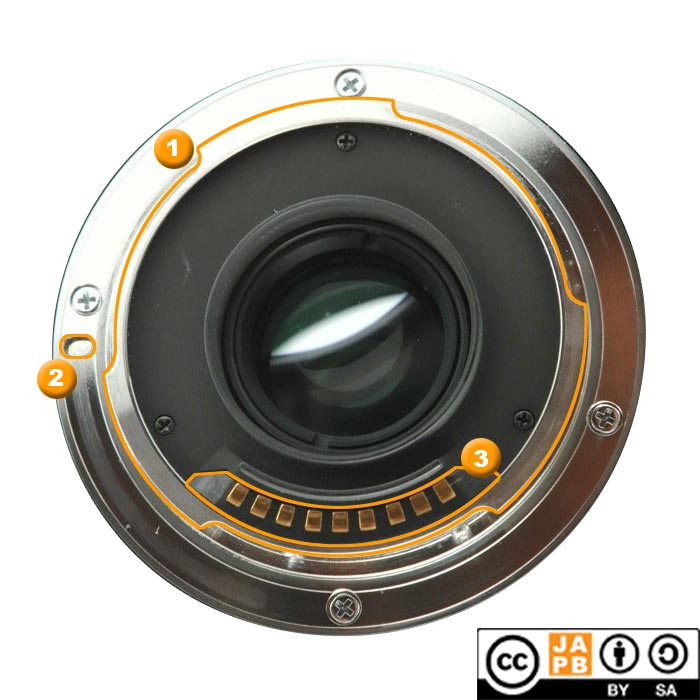Pekka Buttler (Updated 5/2025)
Note! This article is about the 2003–2010 digital SLR lens mount. The related mirrorless mount (the Micro Four Thirds -mount is discussed separately)
Four Thirds mount specifications and identification
Mount type: Bayonet mount (lens release on camera)
Flange focal distance: 38,58 mm
Sensor size: 17,3 x 13 mm
Mount communication:
• electronic only (aperture, autofocus, focusing distance)
• 11 electronic contacts (spring-loaded at the camera’s end)

[1] Three-pronged bayonet. All edges tapered.
[2] Locking groove at 09:00.
[3] 9 electronic contacts (spring-loaded at the camera-end) between 05:00–07:00.
Four Thirds – basic history
As the 20th century was nearing the end, it was clear to everyone in photography, that digital interchangeable lens cameras would be the technology that would unseat the pro, film SLR as the weapon of choice of most (if not all) professional photographers. Importantly, most industry giants used the approach of simply trying to retrofit their existing flagship SLRs with digital sensors (and unavoidable electronics). At the same time, it seemed obvious that larger sensors would – for the foreseeable future – remain significantly more expensive than smaller sensors. Hence, most flagship manufacturers (Canon, KonicaMinolta, Nikon, Pentax) were simply cramming APS-C sized sensors into camera bodies designed with the prime requirement of a 36 x 24 mm shutter opening (and whatever else film needed).
That this approach was in many ways suboptimal was blatantly obvious to all. Nevertheless, the major contenders, did not want to break with (their) traditions, likely in part because there was some synergy to be had: All the pro lenses would serve (albeit with a crop factor) on digital, and technologies could be shared between film and digital.
Olympus – after having de facto withdrawn from SLR development in the 1990s – did not have this ballast. In 2003 Olympus re-entered professional SLR manufacture with a bang: The introduction of the Olympus E-1 dSLR, a new lens mount, a lineup of custom-built lenses, and a custom adapter to allow using film-era Olympus lenses.
That lens mount – the Four Thirds lens mount – was the first lens mount designed specifically with Digital Photography in mind. It broke with tradition on several fronts:
1) Aspect ratio: The Four Thirds system’s aspect ratio is 4:3 (in contrast to the more common 3:2). Some consider 4:3 to be more to their liking, others disagree
2) Sensor Size: While APS-C (23,6 x 15,7 mm) had become something of an dSLR industry standard, the Four Thirds format uses a sensor with the dimensions 17,3 x 13 mm. This meant that while APS-C sensors had a ‘crop factor’ of about 1,5–1,6 , Four Thirds implied a crop factor of ≈2.
3) Due to the smaller sensor, the redesigned mirror box, and the lack of needing to consider an installed base, the Flange Focal Distance of the Four Thirds Mount was designed to be very short (for an SLR).
Olympus did not keep their innovation for themselves. Instead, by 2006 Seven companies (including Olympus, Panasonic and Leica) had signed up for the Four Thirds mount.
Adapting Four Thirds lenses
Four Thirds lenses are, even though technically no longer current, for the most part thoroughly modern lenses, and depend extensively on electronic camera-lens communication to allow aperture control.
Hence the usability of electronic Four Thirds lenses (except on a four thirds body) depends wholly on the existence of a suitable smart adapter. While the availability of such smart adapters from Four Thirds to Micro Four Thirds (MFT) can be taken for granted, currently no such adapters to other mirrorless mounts seem to exist.
In the case of non-electronic (manual) Four Thirds lenses, the situation concerning adapting is much improved, as such lenses can be used on a wide range of mirrorless mounts using a simple dumb adapter.
Adapting Four Thirds lenses to other dSLRs is impractical due to the significantly shorter flange focal distance of the Four Thirds mount.
Adapting to Four Thirds cameras
When the Four Thirds system was launched in 2003, it was by far the dSLR mount with the shortest flange focal distance (≈5 mm shorter than Canon EF). Hence, it opened up a range of legacy lenses for adapting that to date could only be adapted using an adapter with corrective optics (mounts such as Canon FD, Minolta SR and Fujica X). This was good news for the owners of a wide spectrum of legacy lenses who in the Four Thirds system found an uncommonly inviting platform for adapting legacy lenses.
At the same time, the Four Thirds mount introduced a problem of its own, in that the significantly smaller sensor also implied a significant crop factor to the use of adapted lenses.